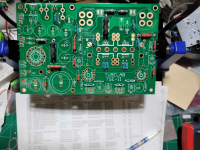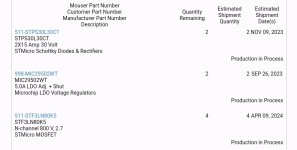George,
Sorry that you've had to fund the business and sorry to see your business go.
It looks like BOM 1.2 is good from a Mouser/Digi-key stock standpoint?
Also, have you ever run a 46 in the TSE? Obviously, bias and B+ would have to be adjusted.
Cheers,
Greg
Sorry that you've had to fund the business and sorry to see your business go.
It looks like BOM 1.2 is good from a Mouser/Digi-key stock standpoint?
Also, have you ever run a 46 in the TSE? Obviously, bias and B+ would have to be adjusted.
Cheers,
Greg
Did you check octopart.com?
I have used STF3N80K5 as replacement.
Newark has the regulator.
I have used STF3N80K5 as replacement.
Newark has the regulator.
George,
Sorry that you've had to fund the business and sorry to see your business go.
It looks like BOM 1.2 is good from a Mouser/Digi-key stock standpoint?
Also, have you ever run a 46 in the TSE? Obviously, bias and B+ would have to be adjusted.
Cheers,
Greg
Make sure you get a 2 or 3 watt part for R5, instead of what’s in the BOM.
Thanks for the tip and suggestions, will definitely check those parts out.
Also pay particularly attention to the power transformer you select. Going with George’s favorite Hammond is the easier route.
Hi Everyone,
Ok I am stumped. I thought I had found the wire diagram for this but lost it and have just been through Tubelab site but am missing it. I am wiring up the TSEII using RCA inputs. I am using a pre-amp and not a passive volume control. I think this is correct:
L Input 1 - rca Input
L Input 2 - rca ground
R input 3 - rca input
R input 2 - rca ground
Is this correct?
erick
Ok I am stumped. I thought I had found the wire diagram for this but lost it and have just been through Tubelab site but am missing it. I am wiring up the TSEII using RCA inputs. I am using a pre-amp and not a passive volume control. I think this is correct:
L Input 1 - rca Input
L Input 2 - rca ground
R input 3 - rca input
R input 2 - rca ground
Is this correct?
erick
Here's how I connected mine- the negative is marked with a straight vertical line, positive is +.

Correct. L-Input 1 and R-Input 3 are the inputs, the rest are all grounds.
......Assuming that R15/R26 can be increased in the original TSE to increase gain since it's been discussed here a few times....
I've built a 45 and a 300B version of the TSE with the original 121K resistors and .22uf coupling caps in both amps.
I could use a little more gain in both amps since I'm using the original miniDSP 2x4 as an active crossover with the amps feeding 2 way speakers and I think the miniDSP output is somewhat limited to the amps. When I run the same setup with my baby hueys and Poindexter EL34 PP amps I have lots of extra headroom, but I've got everything maxed with the TSE's.
Can someone post the formula for the corner frequency? I'm ok with raising the corner freq since I'm running subwoofers up to about 150hz, although leaving the corner frequency relatively low is fine since I can set a HPF in the mini DSP.
*speakers are 97db+ sensitivity
I've built a 45 and a 300B version of the TSE with the original 121K resistors and .22uf coupling caps in both amps.
I could use a little more gain in both amps since I'm using the original miniDSP 2x4 as an active crossover with the amps feeding 2 way speakers and I think the miniDSP output is somewhat limited to the amps. When I run the same setup with my baby hueys and Poindexter EL34 PP amps I have lots of extra headroom, but I've got everything maxed with the TSE's.
Can someone post the formula for the corner frequency? I'm ok with raising the corner freq since I'm running subwoofers up to about 150hz, although leaving the corner frequency relatively low is fine since I can set a HPF in the mini DSP.
*speakers are 97db+ sensitivity
Last edited:
..answering my own question here after searching around the forum .....1/(2piRC) appears to be the formula for corner frequency.......calculating a correct R appears to be a bit tricky...
Thanks Tom!The original TSE had anywhere from 100K to 470K resistors installed for R15 and R26. I have increased this to 1 MEG for the TSE-II in order to boost the gain a little. This gives a 10 Hz corner frequency with a 0.1 uF coupling cap.
I wouldn't use a cap much larger than 1 uF and reduce the value of R15 and R26 if you go that large. In this design the coupling cap works into a high impedance, the 1 meg resistor and a couple of pF in the mosfet. This makes minor imperfections in the coupling caps a non - issue. super expensive caps are really not needed, but you can use them if you prefer, just keep the value near 0.1uF
Using f=1/(2piRC) with the above values (1 meg and .1uf) I get 1.59Hz; George got around 10Hz.......what am I missing? Are there some parallel plate resistances or something that I need to include?
Uh, Dumm Blonde thinking. 1.6 Hz is correct. I forgot the 2pi in the denominator.
You don't want too low of a corner frequency or the bias pot will respond slowly and OPT's generally don't like really low frequencies either.
I just looked at my TSE-II that has some glowing blue Chinese 2A3's installed. It has 1 meg resistors and .15uF caps. It also has big Hammond 1628SEA's wired for 2500 ohms. The real low frequency limit is my Yamaha NS-10M Studio monitors that have no response below 70 Hz and are well above 8 ohms below 100 Hz.
I built three TSE-II's when I got the first boards back in 2019 and haven't made one since.
You don't want too low of a corner frequency or the bias pot will respond slowly and OPT's generally don't like really low frequencies either.
I just looked at my TSE-II that has some glowing blue Chinese 2A3's installed. It has 1 meg resistors and .15uF caps. It also has big Hammond 1628SEA's wired for 2500 ohms. The real low frequency limit is my Yamaha NS-10M Studio monitors that have no response below 70 Hz and are well above 8 ohms below 100 Hz.
I built three TSE-II's when I got the first boards back in 2019 and haven't made one since.
Ok, excellent! .........next question.......is calculating the difference in gain when R is increased straightforward?
Happy New Year, everyone!
I've just treated myself with a nice Mouser BOM order for my new TSE-II board. This is will be a very long term project for me, as I really love the SSE that I built a few years ago and I have other priorities. I just wanted to secure all the parts before some of them once again become unobtanium. I'll be making very good use of this thread over the coming months (maybe years). Thanks to all!
I've just treated myself with a nice Mouser BOM order for my new TSE-II board. This is will be a very long term project for me, as I really love the SSE that I built a few years ago and I have other priorities. I just wanted to secure all the parts before some of them once again become unobtanium. I'll be making very good use of this thread over the coming months (maybe years). Thanks to all!
Hey thanks Zia! Long time no "see". My life has been a bit crazy. Will try to catch up with you soon!
I'm struggling with tube choice here. I've seen enough 2A3 bashing that I had written them off (not to mention the massive filament current requirement), and the 300B seems like overkill (and even the new production 300B are very expensive). I was really thinking 45 were the way to go. Now I realize that finding strong 45 at a good price is going to be extremely difficult. I don't mind shelling out some money, but I want to be certain I am getting what I pay for.
I am sure many have struggled with this dilemma before me. What's the accepted wisdom? What questions do I need to answer for myself? Where to get some 45 tubes that won't be a total waste of money?
I am sure many have struggled with this dilemma before me. What's the accepted wisdom? What questions do I need to answer for myself? Where to get some 45 tubes that won't be a total waste of money?
- Home
- More Vendors...
- Tubelab
- After a 14 year run, the TSE must DIE!

